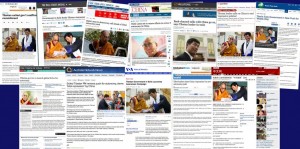A new global awareness campaign, Umaylam: The Middle Way Approach, launched by the Tibetan Government-in-exile (the Central Tibetan Administration or CTA) on June 5, is “the most concerted effort to date to secure basic freedom” for the Tibetan people through “genuine autonomy”, according to Dr Lobsang Sangay, the elected political head of the CTA. The campaign aims to clarify CTA proposals for Tibetan autonomy within China and counter misinformation about the Middle Way policy to a broad cross-section of the international community.
The Middle Way policy was first established in 1974 by His Holiness the Dalai Lama and has since gained the support of international leaders, the most recent being Barak Obama, as well as that of Chinese intellectuals such as Nobel Laureate Liu Xiaobo . It seeks genuine autonomy for the Tibetans within the Chinese constitution through a middle path “between repression and separation from China”. The campaign materials make clear how long the Middle Way policy has been adopted, its impact to date and intentions for the future.
They include an interactive website, a seven-minute documentary video, a social media campaign with regular Facebook and Twitter updates, a timeline of the Tibetan struggle and FAQs in several languages. During an inauguration ceremony in Dharamshala, which attracted wide press coverage, the information materials were presented to His Holiness the Dalai Lama for blessing.

Major international news media yesterday covered the launch of the CTA’s renewed Middle Way Approach international campaign
Photo: Tibet.net
The campaign launch follows a stalemate in talks (nine rounds from 2002 and 2010) between Beijing and Dharamshala. China accused the Tibetan side of seeking disguised independence following the 2008 Memorandum on “Genuine Autonomy for the Tibetan People” – a memorandum from the Tibetan Government which clearly respects China’s territorial integrity, while setting out core Tibetan needs within China, such as cultural and environmental preservation and protection. Dr Sangay has spoken of deliberate attempts by Chinese officials and representatives to mislead international leaders about the Tibetan strategy.
He also spoke about “total repression and total discrimination” in Tibet, which is driving protest and resentment towards the Chinese government and policies. Since 2009, 130 Tibetans have burned themselves alive in protests resulting in 112 deaths. Beijing’s response has been the deployment of more security forces, and increased surveillance and restrictions. In an interview Dr Sangay expressed his hopes for a resumption of formal talks and a softening of China’s policies.





 Print
Print Email
Email